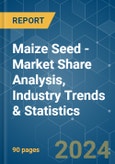The Maize Seed Market size is estimated at USD 24.08 billion in 2024, and is expected to reach USD 33.19 billion by 2030, growing at a CAGR of 5.49% during the forecast period (2024-2030).
Key Highlights
- Hybrids is the Largest Breeding Technology: There is an increase in the demand for hybrid seeds due to higher productivity, wider adaptability, and a high degree of resistance to biotic and abiotic stresses.
- United States is the Largest Country: The United States is the largest country because of an increase in exports, is the leading producer of corn, and an increase in the demand for biofuel extraction.
- Open Pollinated Varieties & Hybrid Derivatives is the Fastest-growing Breeding Technology: Open-pollinated varieties require fewer inputs, such as fertilizer and pesticides, and are less expensive than hybrid seeds and more affordable for low-income farmers.
- Argentina is the Fastest-growing Country: Argentina is the fastest country due to the increase in the adoption of transgenic hybrids, increase in market prices, and demand from the neighboring countries for ethanol.
Maize Seed Market Trends
Hybrids is the largest Breeding Technology
- In 2021, hybrids held a major share of 92.4% of the global maize seed market. Open-pollinated varieties and hybrid derivatives held an 7.6% share. The hybrid segment is estimated to grow by 26.3% from 2022-2028 in terms of value. The demand for hybrids is increasing because of the variety of traits available in hybrids.
- In 2021, open-pollinated varieties and hybrid derivatives accounted for only 7.6% of the global maize seed market. In North America, the United States dominated, with 83.5% of the open-pollinated varieties and hybrid derivatives seed market, followed by Mexico. Together, the two countries accounted for 53.4% of the global market share.
- In hybrids, transgenic hybrids account for 49.7% of the hybrid maize seed market. Non-transgenic hybrids account for 50.3% of the market. Transgenic hybrids are expected to grow, registering a CAGR of 4.0%. North America is the major user of transgenic hybrids in the world due to the demand from the livestock industries.
- The herbicide-tolerant corn seed segment accounts for the majority of the transgenic corn seed market because weeds reduce crop production and affect growers' profits by 30%-40%, owing to crop damage.
- In South America, the usage of hybrids is 100.0%. GM maize hybrids were fully approved by the major producing countries in the region, and insect- and herbicide-resistant corn seeds are widely available in the region.
- The usage of open-pollinated varieties is high in Africa. Ghana holds the first position in the usage of open-pollinated varieties, accounting for 84.5% of the country's maize seed market in 2021.
North America is the largest Region
- In 2021, the maize seed market accounted for 65.0% of the global grain and cereal seeds market. This is expected to increase by 26.5% during the forecast period due to the increase in the high-yielding varieties and demand for consumption as it is the major staple food and an increase in the demand from the livestock industry.
- Globally, North America had the largest maize seed market in 2021. The United States is the largest corn producer in the region, accounting for 39.6% of the global maize seed market in terms of value. The productivity of corn per acre is high in the United States because of the high usage of hybrids and GM corn in the country.
- After North America, Asia-Pacific was the largest maize seed market in the world. The major countries in the region are China and India, which together accounted for 26.2% of the global maize seed market in 2021. The acreage under corn cultivation in China was 42.4 million ha in 2017, which decreased to 41.3 million ha in 2020. Despite the decrease in area, production increased. The increase in production was mainly due to increased yield because of improved cultivars usage in the country.
- In Europe, France has the largest maize seed market, accounting for 3.6% of the global maize seed market. This share is consistently increasing due to the increase in seed sowing area with the increase in the usage of commercial seeds. The area is expected to increase by 8% during 2022-2028.
- The increase in the availability of high-yielding varieties and the increase in the research on stress-tolerant and disease-resistant varieties by private companies are expected to be the driving factors of the maize seed market in the forecast period.
Maize Seed Industry Overview
The Maize Seed Market is moderately consolidated, with the top five companies occupying 53.23%. The major players in this market are Bayer AG, Corteva Agriscience, Groupe Limagrain, KWS SAAT SE & Co. KGaA and Syngenta Group (sorted alphabetically).Additional Benefits:
- The market estimate (ME) sheet in Excel format
- 3 months of analyst support
Table of Contents
1 EXECUTIVE SUMMARY & KEY FINDINGS2 REPORT OFFERS7 KEY STRATEGIC QUESTIONS FOR SEEDS CEOS
3 INTRODUCTION
4 KEY INDUSTRY TRENDS
5 MARKET SEGMENTATION
6 COMPETITIVE LANDSCAPE
8 APPENDIX
Companies Mentioned (Partial List)
A selection of companies mentioned in this report includes, but is not limited to:
- Advanta Seeds - UPL
- Bayer AG
- Charoen Pokphand Group (C.P. Group)
- Corteva Agriscience
- Groupe Limagrain
- Hefei Fengle Seed Industry Co., Ltd
- Kaveri Seeds
- KWS SAAT SE & Co. KGaA
- Syngenta Group
- Yuan Longping High-Tech Agriculture Co., Ltd
Methodology

LOADING...










